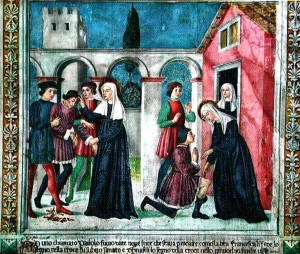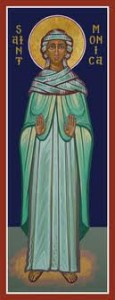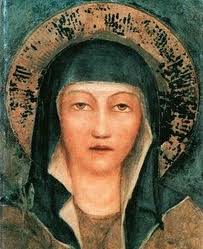 Msgr. Pope did a great job introducing us to the pastoral letter on the New Evangelization and we will continue to write about it as it becomes a way of life for Catholics in the archdiocese.
Msgr. Pope did a great job introducing us to the pastoral letter on the New Evangelization and we will continue to write about it as it becomes a way of life for Catholics in the archdiocese.
One dimension of the New Evangelization is engaging people in conversation and not missing an opportunity to propose that the Catholic faith has the best answers to life’s biggest questions.
In the Beginning
This came to mind, when I saw the news about Stephen Hawkings new book. I started to write something about it and realized I would not be able to make sense of the argument in the space of a blog, but, I knew who could do it. Alfred Turnipseed is the Coordinator of Christian Initiation for the archdiocese and a former astronomy major. Alfred has a real gift for taking complicated concepts and breaking them down in a way that not only makes sense but that you can remember the next time it comes up in conversation. So, Alfred is my guest blogger today. I will be happy to pass any questions along to him for answers.
From the desk of Alfred Turnipseed
That day began like any other workday: I arrived at work, turned on my desktop computer, and waited what seemed to be a thousand years for it to boot up. Thus I began my daily “ritual”: After checking my emails, I opened Internet Explorer so as to peruse the headlines on Yahoo’s homepage.
That’s when I saw it: “God did not create the universe, says Hawking”.
At first, I thought it was a joke. When I clicked the link, I fully expected to be taken to a page at The Onion. And that’s when I discovered—this is for real. “He finally did it,” I said to myself. “He just had to go ahead and blow it all, dagnabbit…!”
He, by the way, is Stephen Hawking, British theoretical physicist and cosmologist, the recently retired Lucasian Professor of Mathematics at the University of Cambridge (a post once held by the great Isaac Newton), and author of the internationally best-selling A Brief History of Time—the Most Celebrated Scientist In The World.
My “dagnabbit” (or some such term denoting extreme irritation caused by grave scandal) spontaneously came to mind because Hawking is also a lifetime member of the Pontifical Academy of Sciences, who famously once wrote, “If we discover a complete theory [of the universe], it would be the ultimate triumph of human reason—for then we should know the mind of God.”
(It would seem that for Hawking, science has proved that God is so unnecessary as not to exist at all. So much for “knowing the mind of God.”)
Okay. So what did Hawking actually say during this, his most recent “declaration”? His words, taken from his new book, The Grand Design—words which stir new passions in me every time I read them—are as follows: “Because there is a law such as gravity, the universe can and will create itself from nothing. Spontaneous creation is the reason there is something rather than nothing, why the universe exists, why we exist. It is not necessary to invoke God to light the blue touch paper and set the universe going.”
Now, I admit it: ever since I gave up my astronomy studies (at Cornell, no less) for philosophy (and eventually, theology), I’ve had a slight case of “scientist-envy.” After all, theoretical physicists can get away with saying things that—were I to say them—would get me at least puzzled stares and at most laughed out of the room! I mean, the most eminent cosmologist on Planet Earth has declared that our 13.7-year-old, goodness-knows-how-big universe just popped into existence (1) from nothing, (2) by itself, and (3) that this was all a result of gravity. Let’s look at Hawking’s statement point-by-point.
1. From Nothing: These words should be familiar to all well-catechized Catholics. The Latin term is ex nihilo. Indeed, Catholics do believe that the universe and everything in it came into existence out of nothingness (see the Catechism of the Catholic Church, Nos. 296-298), or in the words of Bible, “I beg you, child, to look at the heavens and the earth and see all that is in them; then you will know that God did not make them out of existing things…” (2 Maccabees 7: 28). So far, so good.
2. By Itself: Now here’s where things start getting ugly. There is an old saying in Latin—ex nihilo nihil fit—”nothing comes from nothing”. Now, here, we must be careful. As stated just above, Catholics clearly believe not only that something can come from nothing, but that everything comes from nothing; that’s what creatio ex nihilo (“creation out of nothing”) means. For Catholics, then, “nothing comes from nothing” must express something (pun intended!) more sublime—namely, that by itself, only nothing can come from nothingness. To speak somewhat more subtly—nothingness, in and of itself, does not provide sufficient reason for anything to exist.
3. Everything is a result of gravity: Nevertheless, Hawking does seem to think that nothingness can provide sufficient reason for the universe to exist, and for him, this reason is “gravity”. But here’s the rub: whatever gravity is (whether a force, a law of physics, a mathematical reality, etc.), it is definitely not nothing. In other words, whatever Hawking means by nothing (physical nothingness) he can’t mean what the Catholic Church means by nothing (metaphysical nothingness). For the Church, nothing doesn’t simply mean “no matter,” “no energy,” and “no forces”; nothing means nonexistence (once again, read 2 Maccabees 7: 28 above). Now, even Hawking would have to agree that gravity possesses some type of existence. So whatever Hawking means by nothing, he can’t mean nonexistence, since gravity exists. What, then, is Hawking saying? He seems to be saying that in the beginning, there was gravity (which, in Hawkingspeak, exists, but is also nothing), and from gravity, all things that now exist, exist. Does this make any sense to you? Yeah, I didn’t think so!
Hawking’s statement denying the existence of, and even need for, God, has caused something of an uproar among those who care about the (seemingly) competing claims of science and religion to explain everything. In Great Britain, the Anglican Archbishop of Canterbury, the Catholic Archbishop of Westminster, and prominent Jewish and Muslim leaders have condemned Hawking’s “scientific atheism” as yet another case of physics overstepping its bounds. After all, as implied above, physics is the science (or philosophy) of matter and its motion, energy, and forces. Metaphysics (“beyond physics”), on the other hand, is the philosophy (or science) of being and existence. So, as soon as one starts making declarations about existence, one crosses the line from physics into metaphysics. Given all this, it really makes no sense to apply the laws of physics—or the principles of mathematics—to questions of existence. In fact, from the perspective of genuine metaphysics, there is Being/Existence itself, and that which comes into existence or derives its existence from Being/Existence itself. The former is God, and the latter are the principles of mathematics, the laws of physics, and ultimately, the entire universe (including space-time and non-spatial/non-temporal reality). The point: God doesn’t “set the universe going,” as Hawking seems to think believers believe. Rather, God causes everything to be, including the mathematical principles and physical laws that “set the universe going.”
(Note: it makes no difference whether there are, in fact, many universes or even an infinite number of universes—all derive their being from God.)
What does all this demonstrate? Only that Stephen Hawking has no more disproved the existence of God than he has proved the existence of the extraterrestrial intelligent life forms that he so firmly believes in! (Talk about “blind faith”!)
A final thought: If you’ve been reading between the lines, you’ve realized that “proving” or “disproving” the existence of God is not like proving or disproving the existence of some thing. God, after all, simply IS. In other words, “proving the existence of God” is like proving the existence of Existence. I mean, once you realize that for any thing to exist/be, there must be EXISTENCE/BEING, you simultaneously realize that any discussion about God puts you in a whole new territory of thought (theology … ha!). In fact, if you start thinking (actually, praying) about this really hard, you might cross into deep spirituality—and you’ll “see” why so many saints and mystics could say that “God is nothing,” because God is not “a” thing, because God IS … and since God IS, in him, we will live forever. “Therefore, since it is the Creator of the universe who shapes each man’s beginning, as he brings about the origin of everything, he, in his mercy, will give you back both breath and life…” (2 Maccabees 7: 23).
“The mathematics of the universe does not exist by itself, nor … can it be explained by stellar deities. It has a deeper foundation: the mind of the Creator. It comes from the Logos, in whom, so to speak, the archetypes of the world’s order are contained. The Logos, through the Spirit, fashions the material world according to these archetypes. In virtue of his work in creation, the Logos is, therefore, called the “art of God”…. The Logos himself is the great artist, in whom all works of art—the beauty of the universe—have their origin” (Joseph Ratzinger/Pope Benedict XVI).
 Last week I wrote about people in the archdiocese putting evangelization into practice by making the sign of the cross and praying grace in public places. Of course, this is not something new. In this painting, the great early 15th century English mystic, Julian of Norwich, is making the sign of the cross as she blesses a person seeking her prayer.
Last week I wrote about people in the archdiocese putting evangelization into practice by making the sign of the cross and praying grace in public places. Of course, this is not something new. In this painting, the great early 15th century English mystic, Julian of Norwich, is making the sign of the cross as she blesses a person seeking her prayer.






